

Netflix Streaming: A Disruptive Innovation That's Disrupting Netflix. Disruptive Innovation. How To Escape The Innovator’s Dilemma. Why do so many great companies fail?

Professor Clay Christensen of the Harvard Business School argued they fail because of something he called The Innovator’s Dilemma – a term he popularized to describe the way in which smart companies become prisoners of their own innovation. So is it possible to escape the innovator’s dilemma? I had the honor of interviewing Clay at The Economist‘s Innovation event in Berkeley last week where the great man talked to me about how Google might escape the innovator’s dilemma, why he worries about Apple’s future, how to effectively innovate in education and healthcare and why most business school professors get the economy so wrong.
This is the second in a week long series of interviews from the Innovation event. Tomorrow, check out my interviews with Vivek Wadhwa on racism in Silicon Valley and GE marketing chief, Beth Comstock, on the oldest start-up in the world. Yrjo Engestrom's homepage. Email: yrjo.engestrom@helsinki.fiTel.: +358-9-191 44574Mobile: +358-50-3076300Fax: +358-9-191 44579 Postal address: Center for Activity Theory and Developmental Work Research P.O.

Box 26 FIN-00014 University of Helsinki, Finland Current Activities. Yrjo-Engestrom. Lev Vygotsky. Lev Semyonovich Vygotsky (Russian: Лев Семёнович Вы́готский or Выго́тский, born Лев Симхович Выгодский (Lev Simkhovich Vygodsky)) (November 17 [O.S.
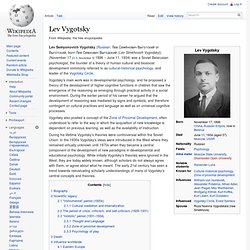
November 5] 1896 – June 11, 1934) was a Soviet Belarusian psychologist, the founder of a theory of human cultural and biosocial development commonly referred to as cultural-historical psychology, and leader of the Vygotsky Circle. Aleksei N. Leontiev. Alexei Nikolaevich Leontiev (Family name also spelled Leont'ev, Russian: Алексе́й Никола́евич Лео́нтьев) (February 18, 1903, Moscow–January 21, 1979, Moscow), was a Soviet developmental psychologist, and the founder of activity theory.
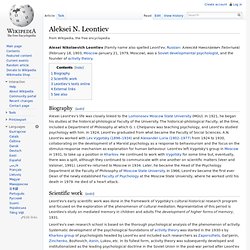
Biography[edit] Alexei Leont'ev’s life was closely linked to the Lomonosov Moscow State University (MGU). In 1921, he began his studies at the historical-philological Faculty of the University. The historical-philological Faculty, at the time, included a Department of Philosophy at which G. I. Scientific work[edit] Lucy Suchman. Lucy Suchman, Ph.D. is a Professor of Anthropology of Science and Technology in the Department of Sociology at Lancaster University, in the United Kingdom.[1] She has taught several courses including Virtual Cultures, Anthropology of Cybercultures, and Gender, Sexuality and Society.
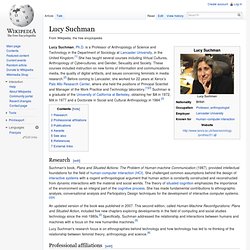
Terry Winograd. Terry Allen Winograd (born February 24, 1946) is an American professor of computer science at Stanford University, and co-director of the Stanford Human-Computer Interaction Group.[2] He is known within the philosophy of mind and artificial intelligence fields for his work on natural language using the SHRDLU program.
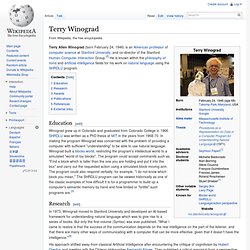
Education[edit] Winograd grew up in Colorado and graduated from Colorado College in 1966. SHRDLU was written as a PhD thesis at MIT in the years from 1968-70. In making the program Winograd was concerned with the problem of providing a computer with sufficient "understanding" to be able to use natural language. Winograd built a blocks world, restricting the program's intellectual world to a simulated "world of toy blocks". Research[edit] In 1973, Winograd moved to Stanford University and developed an AI-based framework for understanding natural language which was to give rise to a series of books. TerryWinograd. About Activity Theory. Activity theory (AT; Russian: Теория деятельности)[1] is an umbrella term for a line of eclectic social sciences theories and research with its roots in the Soviet psychological activity theory pioneered by Lev Vygotsky, Alexei Leont'ev and Sergei Rubinstein.
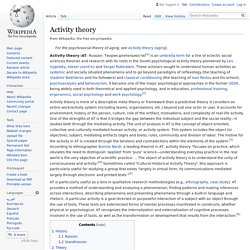
These scholars sought to understand human activities as systemic and socially situated phenomena and to go beyond paradigms of reflexology (the teaching of Vladimir Bekhterev and his followers) and classical conditioning (the teaching of Ivan Pavlov and his school), psychoanalysis and behaviorism. It became one of the major psychological approaches in the former USSR, being widely used in both theoretical and applied psychology, and in education, professional training, ergonomics, social psychology and work psychology.[2] Activity theory is more of a descriptive meta-theory or framework than a predictive theory.
It considers an entire work/activity system (including teams, organizations, etc.) beyond just one actor or user. Approach from Activity Theory. According to activity theory, every situation is an activity and the participants in this activity are the subjects.
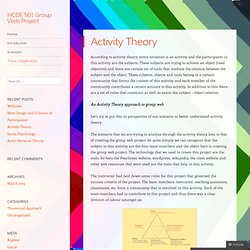
These subjects are trying to achieve an object (read objective) and there are certain set of tools that mediate the relation between the subject and the object. These subjects, objects and tools belong to a certain community that forms the context of this activity and each member of the community contributes a certain amount to this activity. In addition to this there are a set of rules that constrain as well as assist the subject – object relation. An Activity Theory approach to group web.